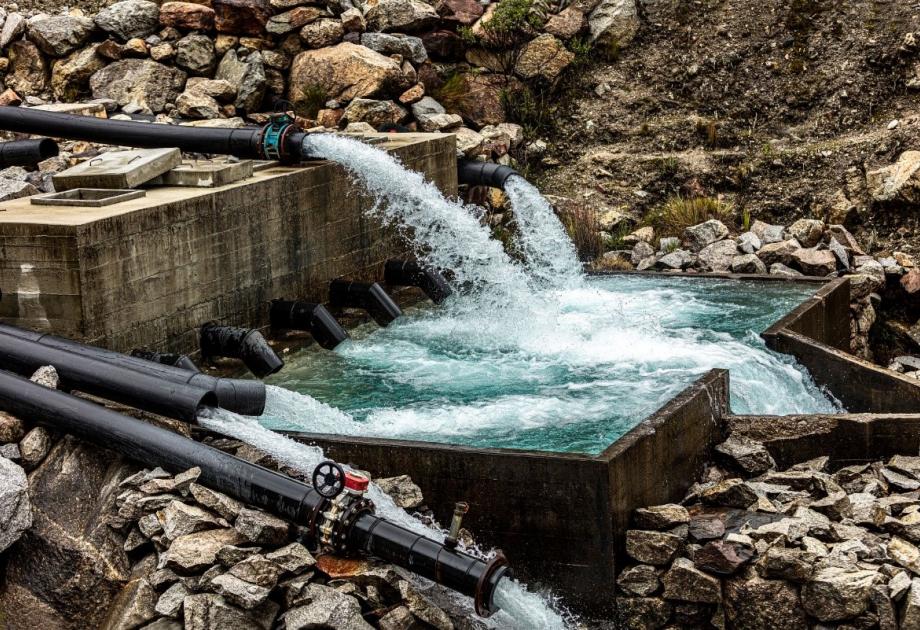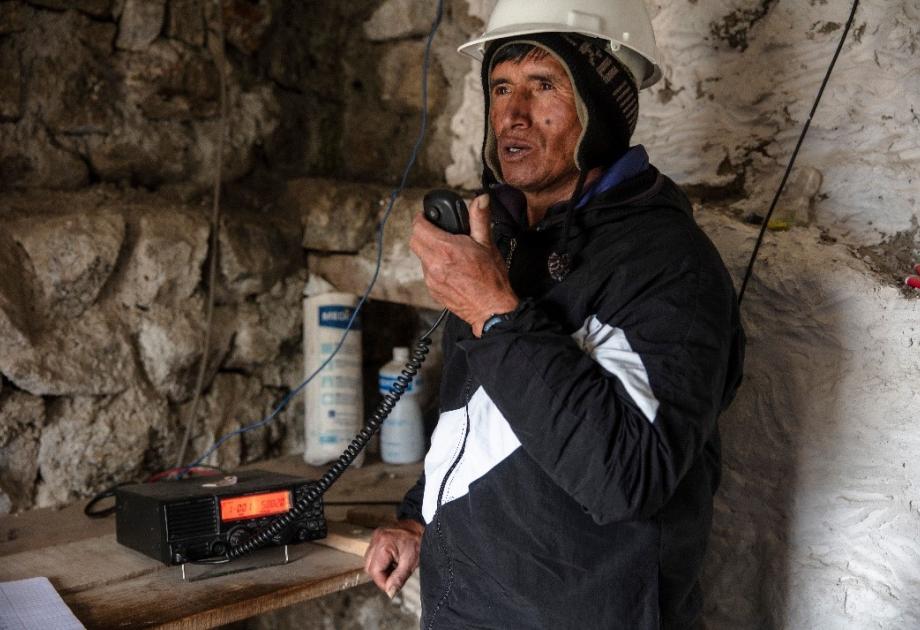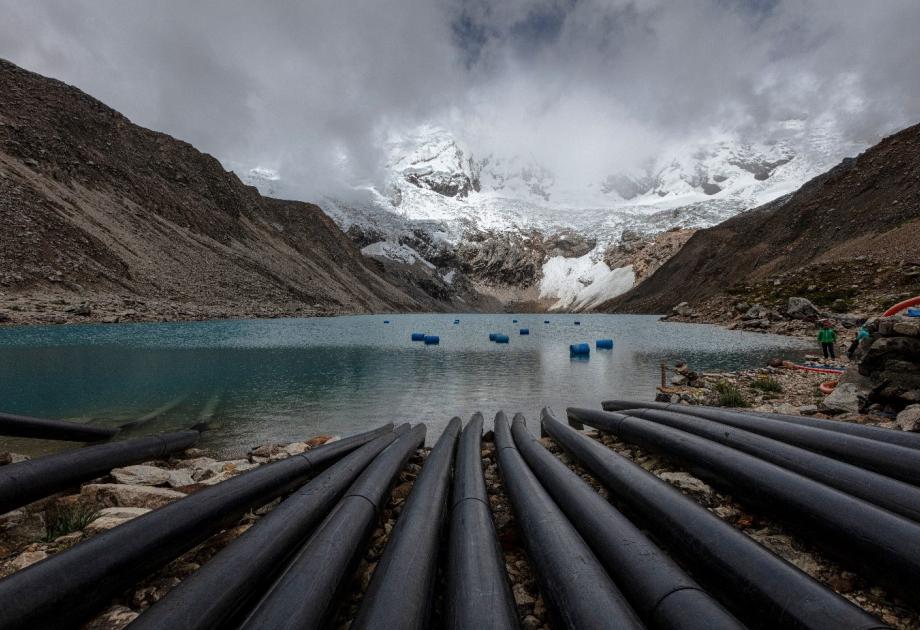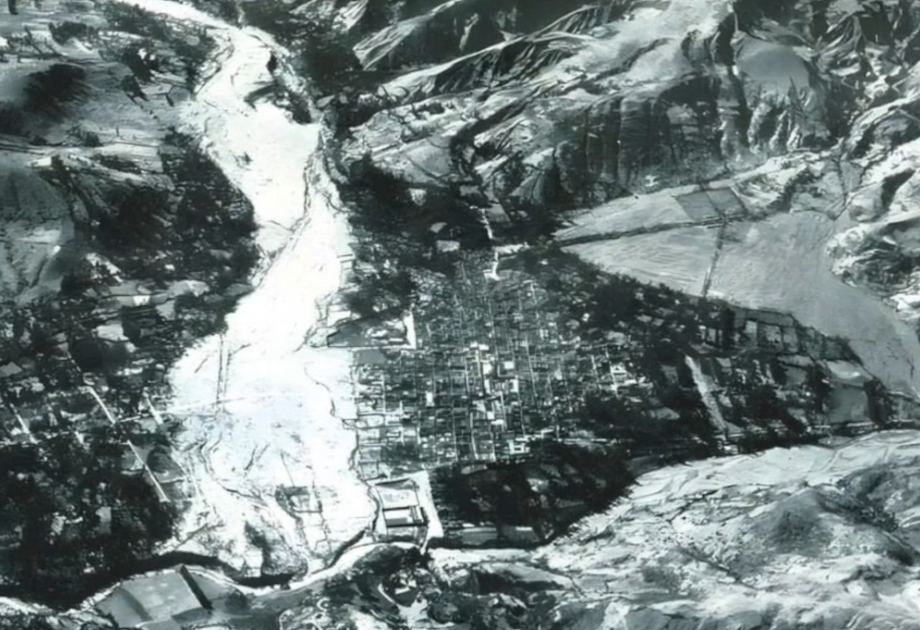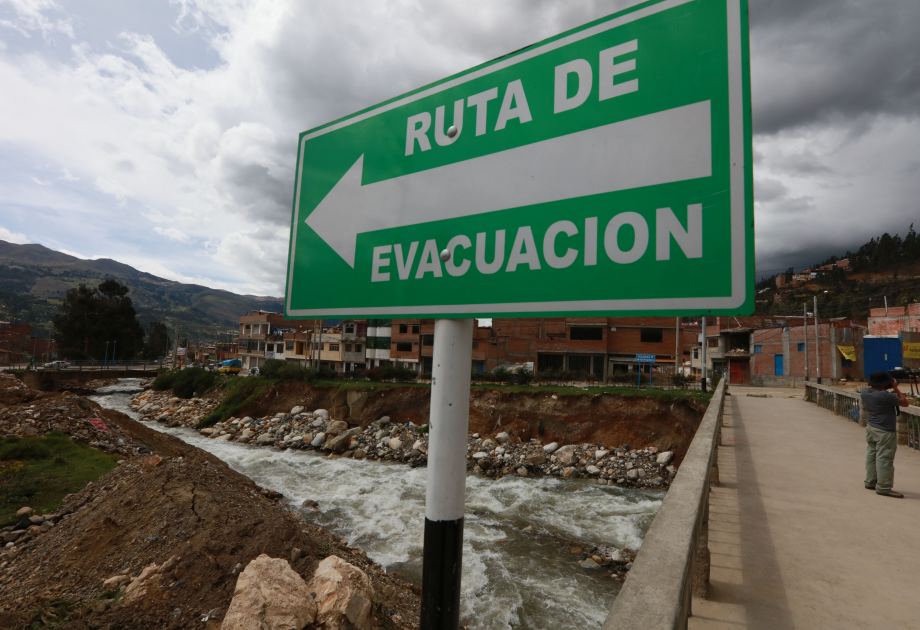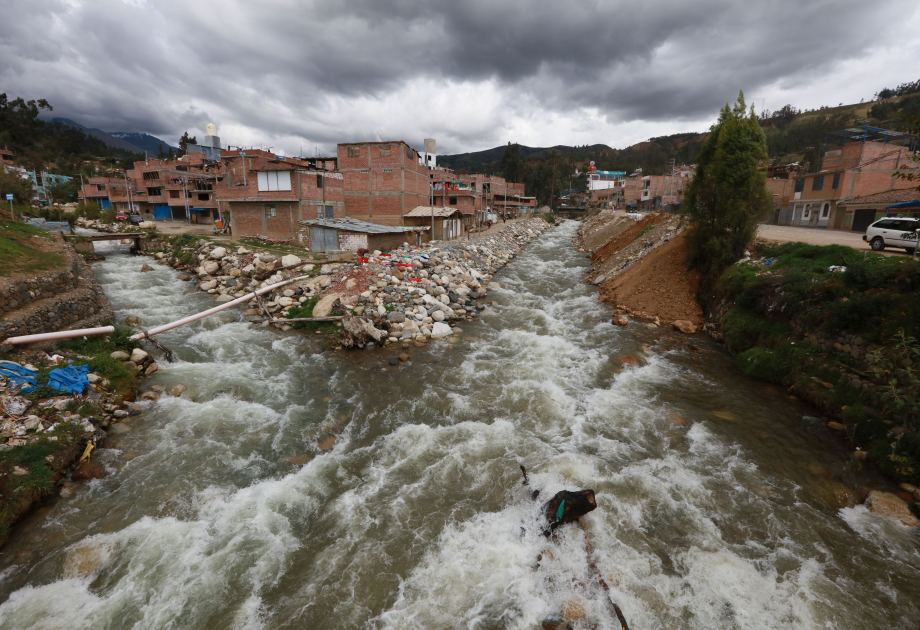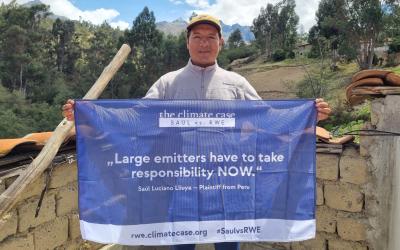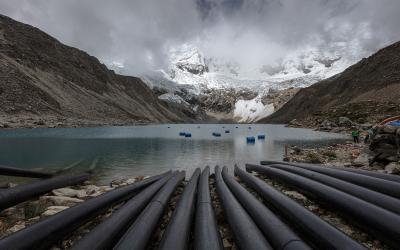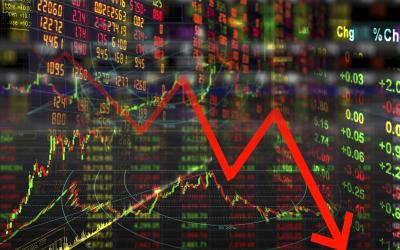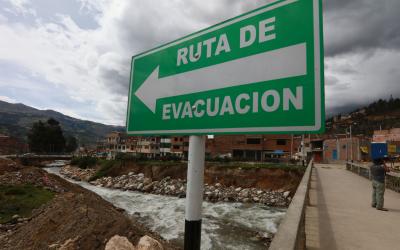

Background
About 10,000 kilometers separate RWE's headquarters in Essen from the plaintiff Saúl Luciano Lliuya in the Peruvian Andes. There, the mountain guide has been experiencing the glacier melt for many years. He is very worried because avalanches and floods have already occurred in neighboring communities. In his lawsuit, he demands that RWE pay a share of the costs for the protective measures required in Huaraz, in accordance with his emissions.
Glacier melt in the Andes
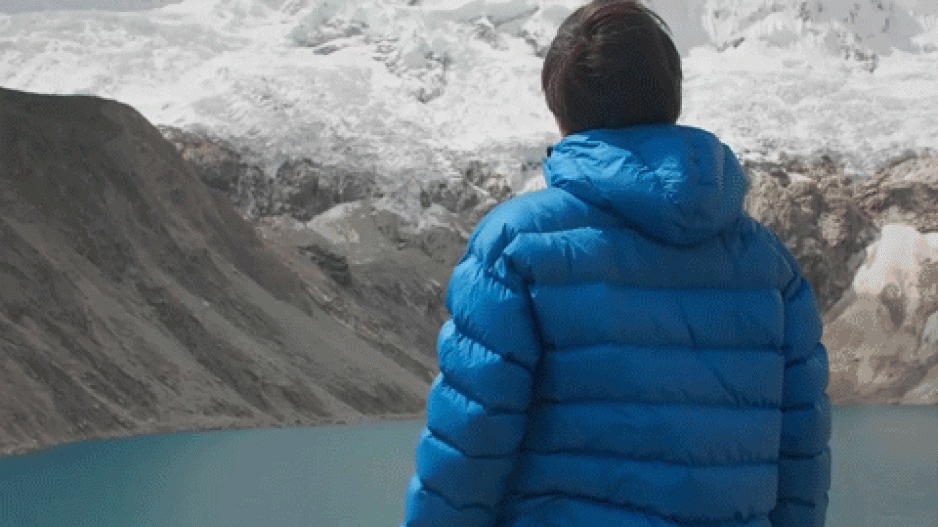
A glacier break at Palcaraju glacier
Saúl Luciano Lliuya and the inhabitants of Huaraz live in danger. The melting of the glaciers due to climate change has caused the water level of Lake Palcacocha above the city to rise for years. Since 2003 alone, the lake has increased more than fourfold, and 34 times since 1970. The risk is increasing that large blocks of ice will break away from the glaciers and fall into the lake. A flood wave would cause meter-high flooding in the lower urban areas.
Already in 1941, several thousand people fell victim to a tidal wave. At that time, a large piece of glacier fell into the lake, which at that time was even smaller than it is today. Peru's disaster management agency warns that a flood could occur at any moment; Palcacocha Glacial Lake is the most dangerous in the region. The last time a minor flood occurred was in 2003. A state of emergency has been declared several times recently.
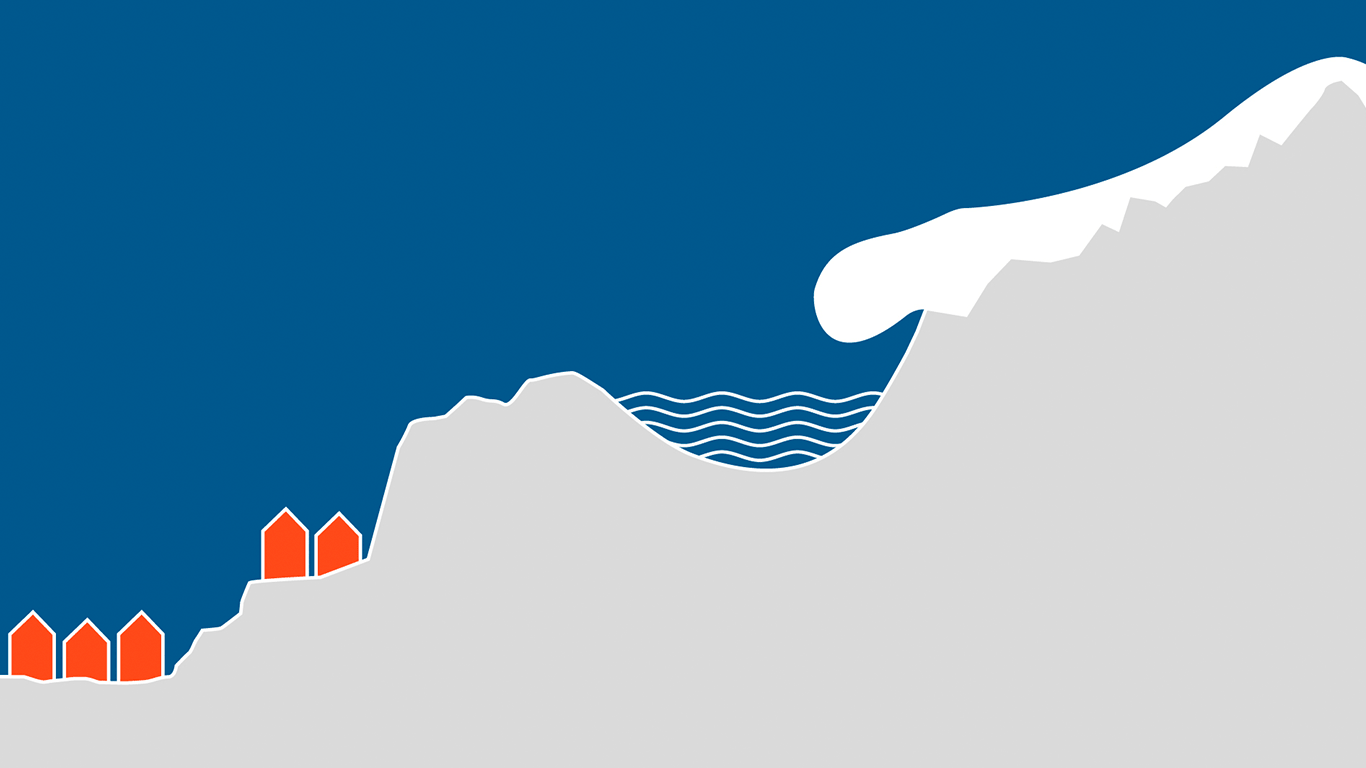
We have no other chance. The glacial lake above my hometown is growing inexorably, and those who are accelerating the melting of the glaciers with their emissions are acting as if they have nothing to do with our emergency situation. You don't have to be a an expert to see that this is wrong.
Saúl Luciano Lliuya
In recent years, temporary hoses have been placed in Lake Palcacocha to pump out excess water and lower the water level. A team of local glacier guards watch the lake around the clock to warn the population in case parts of the glacier break off. They are now better connected to the outside world: Far from the mobile phone signal, they used to have only a radio for communication. In the meantime, an internet connection has been set up and a camera has been installed at the lake. This means that the population can theoretically also watch Palcacocha in a livestream, in practice there are often technical problems.
To avert the danger permanently, the authorities are planning to build a larger protective dam and a new drainage system, in which RWE should participate financially, as Saúl Luciano Lliuya demands in his lawsuit. At the moment, an early warning system is also being installed at the lake to warn the population in case of danger and evacuate parts of the city.
Why RWE?
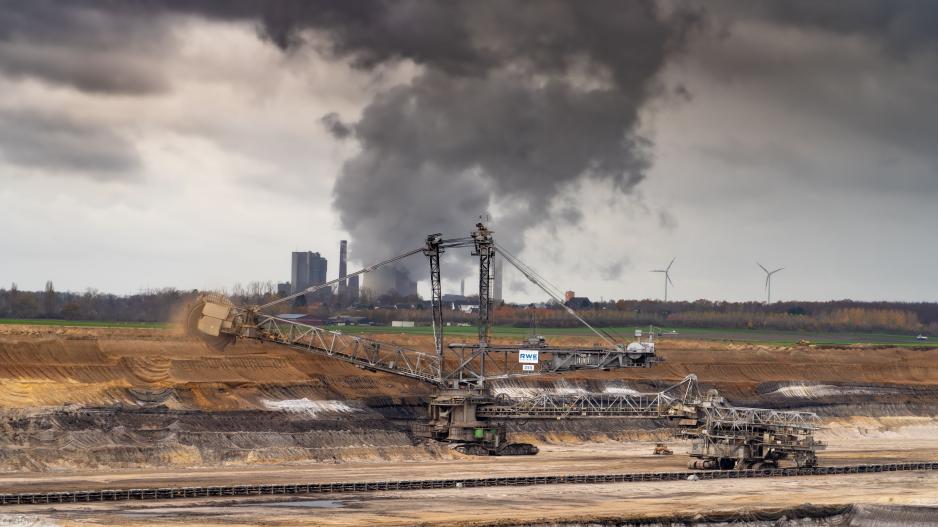
RWE opencast coal mine
RWE is one of the largest CO2 emitters in Europe. According to a study by the Carbon Majors Project from 2014, the company is responsible for around half a percent of global greenhouse gas emissions since the beginning of industrialization. RWE still burns coal today, especially lignite, and thus continues to fuel the climate crisis.
Even though RWE is just one polluter among many, Saúl Luciano Lliuya advocates that major emitters like RWE pay for damages and risks caused by their business model. In RWE's case, the issue is the construction of a protective dam to protect over 50,000 people in Huaraz from an impending flood disaster.
News
Aktuelles
8 Years climate case against RWE
Eight years ago, the Peruvian mountain guide and small farmer Saúl Luciano Lliuya filed his civil lawsuit against RWE at the regional court in Essen in Germany. What began back then has now become one of the world's most recognised precedents for the question of whether individual major emitters must pay for protection against climate risks.
read moreThe long-awaited expert opinion is now available
More than a year after the court visit to the Andean city of Huaraz, the expert report on the flood risk and the impact on the property of the plaintiff Saúl Luciano Lliuya has finally been released. A court-appointed expert prepared the comprehensive document, spanning more than 200 pages, which forms the basis for the next steps in the climate lawsuit of the Peruvian mountain guide against the energy company RWE.
read moreClimate litigation as a significant risk for fossil fuel companies
New scientific study shows that climate lawsuits lead to a significant loss in value for companies with CO2-intensive business models. Researchers show: RWE share fell up to 6 percent due to Saúl Luciano Lliuya's lawsuit at Hamm Higher Regional Court.
read moreSaúl Luciano Lliuya against RWE: expert opinion expected in summer
One year after the court visit to Huaraz, the expert report will finally be available this summer. A hearing at the Higher Regional Court of Hamm is expected later this year.
read moreFAQs
FAQ
As a small farmer and mountain guide, Saúl Luciano Lliuya has been experiencing the consequences of climate change in the Peruvian high Andes for many years. The glacial lake Palcacocha, located a few kilometers above the city of Huaraz, has grown more than fourfold since 2003 alone and 34 times since 1970. Climate change is increasing the risk that large blocks of ice will break away from the glaciers and fall into the lake. This would cause a devastating tidal wave and meter-high flooding in the city. More than 50,000 people live in the danger zone.
In 2014, Saúl Luciano Lliuya and his father spoke to a local agricultural advisor about the effects of climate change in their region They asked him why the main perpetrators of climate change were not held accountable for its consequences. It is unfair that the people living there have to bear the risks alone, even though they contribute little or nothing to climate change. The polluters - wherever they are - should actually ensure protection.
The agricultural advisor then established contact between Saúl Luciano Lliuya and Germanwatch. He was aware of the organization's work on climate justice and knew that staff would be at the COP scheduled in Lima in December 2014. A meeting was organized and the possibility of a model lawsuit against major contributors to climate change was discussed. Germanwatch established contact with the German lawyer Dr. Roda Verheyen. After her legal advice, Saúl decided to file a lawsuit against Europe's largest emitter, RWE. The lawsuit was filed in November 2015.
In his lawsuit, Saúl Luciano Lliuya demands that RWE contributes to the financing of protective measures at the Palcacocha Glacier Lake in an order of magnitude corresponding to the company's share in the causation of global climate change (approx. 0.5%). The construction of a protective dam at the lake will cost about $4 million. Accordingly, RWE is expected to contribute about $20,000. The company would only have to pay if the project is implemented by the peruvian authorities and the plaintiff is charged with the corresponding costs. Saúl Luciano Lliuya would therefore have to pay the contribution to the protective measures and reclaim the amount from RWE. If it is not possible for legal reasons to obtain a contribution to the measures at the lake from RWE, the plaintiff also demands support for measures to strengthen his house against the flood risk.
It was important to Saúl Luciano Lliuya from the beginning that he did not want to profit from such a lawsuit alone. His aims are:
- in the medium term, to protect his town and the people of Huaraz and the region from the dangers of climate change - the main concern is the risk of glacial flooding; in the longer term, there is great concern that glacier retreat could lead to water shortages,
- to make the local population aware of the existing risks and to develop mitigation and adaptation strategies with them (e.g. in cooperation with the local NGO Wayintsik)
- hold the Peruvian authorities accountable for fulfilling their precautionary and protective duties
- create a legal precedent that other climate change victims can refer to in court and that builds additional pressure on policymakers.
The basis for the claim is Section 1004 of the German Civil Code, the general provision of German civil law for protection against interference with property.
Paragraph 1: If property is interfered with in a way other than by deprivation or withholding of possession, the owner may demand that the interferer remove the interference.
Section 1004 is normally applied in practice in neighbour disputes. In the RWE case, the Higher Regional Court of Hamm ruled that climate change, with its cross-border effects, had brought about a kind of global neighbour relationship. In this case, it is about 10,000 kilometers as the crow flies that separate RWE's headquarters in Essen from the plaintiff Saúl Luciano Lliuya in the Peruvian Andes.
RWE describes itself as the largest single CO2 emitter in Europe. It is one of the 100 companies collectively responsible for 70% of global greenhouse gas emissions. According to studies, RWE alone is responsible for 0.5% of man-made emissions since the beginning of industrialization. RWE is still burning coal today, fueling the climate crisis.
- 2015: Filing of the lawsuit at the Regional Court of Essen, court classifies lawsuit as "case of fundamental importance".
- 2016: RWE denies its own responsibility for climate damage in the Andes and denies the flood risk. In the statement of defense, the lawyers claim that there is no liability under German civil law.
The Essen Regional Court rejects the claim on the grounds of a lack of "legal causality". Nevertheless, it conceded a possible "scientific causality." - 2017: Saúl Luciano Lliuya appeals to the Higher Regional Court of Hamm against the negative ruling of the Essen Regional Court.
- During the hearing, the court finds that large emitters such as RWE are fundamentally obliged to support those affected by climate damage in poor countries. The decision to enter the evidentiary fase follows - legal history is written!
- 2018: The Higher Regional Court of Hamm clearly rejects two counter-arguments by RWE's lawyers against the decision to take evidence and repeats: climate damage can give rise to corporate liability.
Two experts are assigned to work on the assessment on the 1st question of proof: Is there a serious threat of damage to the plaintiff's house property? - 2019: The Higher Regional Court of Hamm submits a request to the State of Peru to be allowed to inspect the disputed premises in Huaraz.
- 2020: The site visit to take evidence in Huaraz is further delayed by the Corona crisis and the associated travel restrictions.
- 2022: On-site visit in Huaraz. Judges, legal representatives of the plaintiff and the defendant, and court-appointed experts travel to Peru for the investigation of the 1st question of evidence (see FAQ 6).
- 2023: Court appointed expert delivers report on the 1st question of proof.
Evidentiary question 1: Is there a legally relevant flood risk?
The issue is whether there is a high and imminent risk of flooding to the plaintiff's house. According to several scientific studies, there is such a risk (studies available here and here).
Evidentiary question 2: Does RWE bear partial responsibility for the flood risk?
It is undeniable that RWE has contributed to climate change by burning coal. According to the Carbon Majors study, the company is responsible for about 0.47% of historical emissions. A 2021 study concluded that anthropogenic climate change is responsible for about 95% of the glacier melt on the ground in Peru, and thus the resulting flood risk.
RWE is aware of the impact that bearing the costs would cause. In court, lawyers for the company expressed concern that this could trigger a wave of lawsuits against companies. In the lawsuit, RWE's lawyers denied a relevant flood risk in Huaraz and supported funding a questionable scientific study on the issue. RWE also challenged scientifically proven temperature increases in the Andes. Because of multiple objections by the company, the process has been delayed so far.
The delay in the lawsuit is concerning given the risk situation on the ground: on February 5, 2019, an ice avalanche fell into the glacial lake, triggering 4.5 -meter-high waves that the 7-meter-high dam was able to hold. However, the event shows that the dam is inadequate.
In recent years, temporary hoses have been placed in Lake Palcacocha to pump out excess water and lower the water level. Further measures are being planned. Since the beginning of the lawsuit, Saúl Luciano Lliuya has reinforced the walls of his house to better withstand a flood wave.
The lawsuit is already a major success because, for the first time, a court has affirmed that, in principle, a private company is responsible for its share in causing climate-related damage. This applies if a share of concrete damage or risks to private individuals or their property can be attributed to the company's activities. With this finding and the decision to enter into evidence, the case has already made legal history.
If the two evidentiary issues are resolved in favor of the plaintiff, a judgment against RWE is likely. The company could appeal against this to the Federal Court of Justice. Even if Saúl Luciano Lliuya loses, there could be an appeal. It could take several years before a final decision is reached.
RWE should only be held liable to the extent of its contribution to global warming. Saúl Luciano Lliuya has received a letter from the responsible Peruvian authority that it would use this money as a partial amount for the necessary construction of the protective measures. In other words, an impetus to push ahead with the overdue construction. In addition to the flood protection measures at the glacial lake, the local risk management should include a comprehensive infrastructure project to secure the water supply of the city of Huaraz. The local authorities have planning concepts that include a new dam with an integrated water pumping system as well as plans for a water supply infrastructure (such as reservoirs and canals). The local NGO Wayintsik is trying to build up pressure on the authorities so that the project will be realized.
Germanwatch supports this lawsuit - especially with press and public relations work - in particular because of its character as a model lawsuit to clarify the responsibilities for climate change and its consequences, to support people affected by climate change and at the same time to promote the pressure towards a necessary climate policy change worldwide. Germanwatch is not a plaintiff in the proceedings and, apart from reimbursing the plaintiff's travel expenses to Germany, is not financing any court or legal fees.
The decision to take the arduous path of a model case was made solely by the plaintiff and his lawyer. And all other decisions in the proceedings are also his and his lawyer's alone.
Since this is a test case for the common good, the Foundation has agreed to pay for the necessary expert opinions and the plaintiff's attorney's and court costs, and is calling for donations. Saúl Luciano Lliuya alone would not be able to pay the lawyer's fees and court costs.
Saul Luciano Lliuya depends on donations to pay for his legal fees and court costs. Support the plaintiff with your donation, inform yourself and others about the consequences of climate change and step up for climate justice. Support the plaintiff with your signature and help us draw attention to the climate lawsuit.
Factsheet
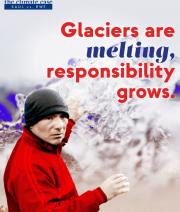
In this factsheet you will find all important information bundled together: The starting position and goals of the lawsuit, a review of the important dates and achievements so far, as well as ways to become active yourself.
